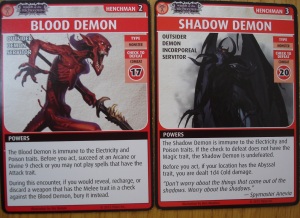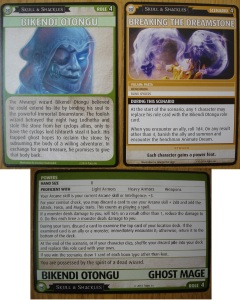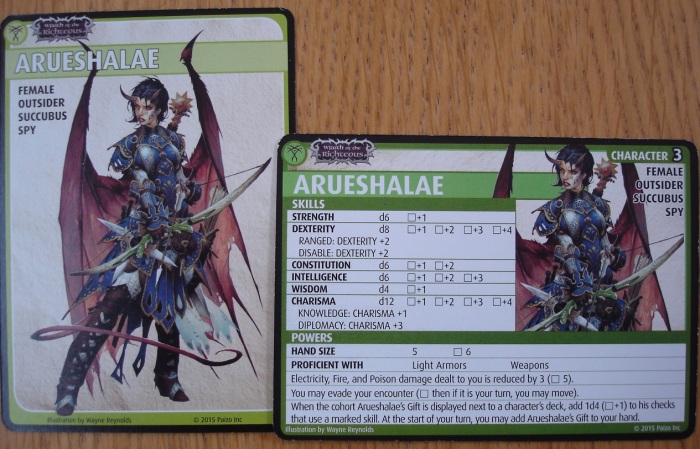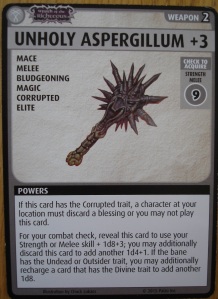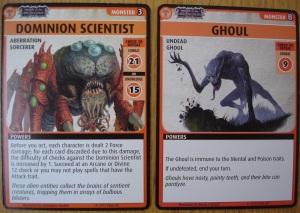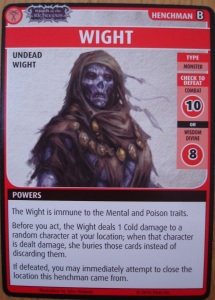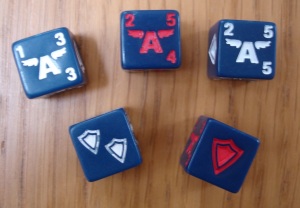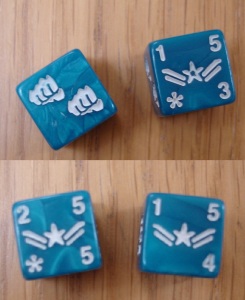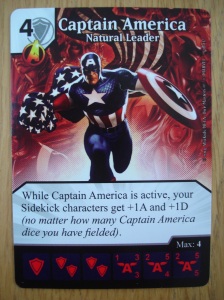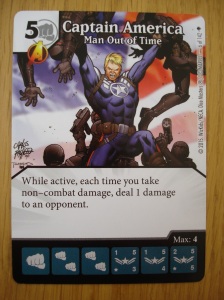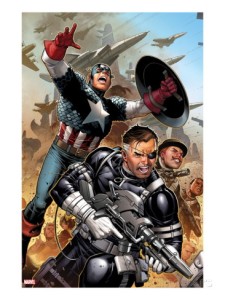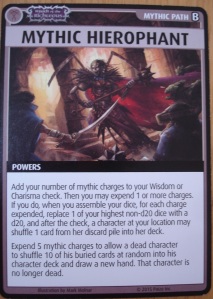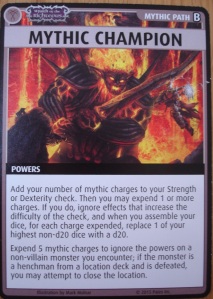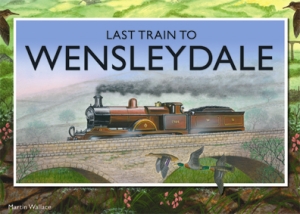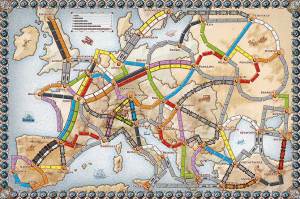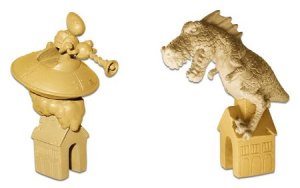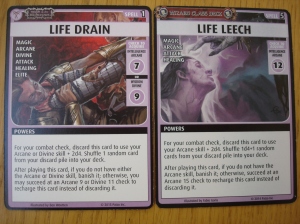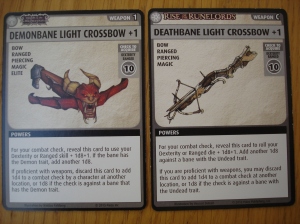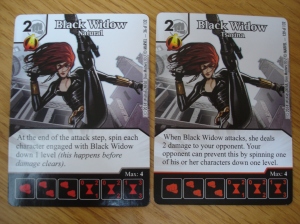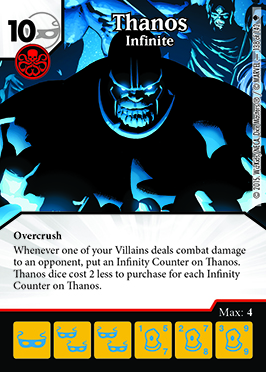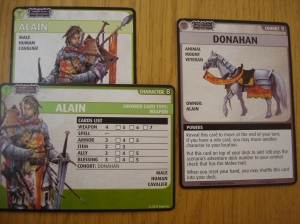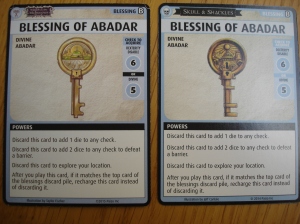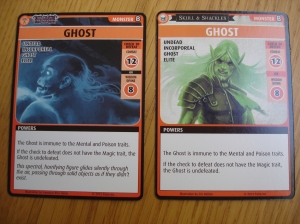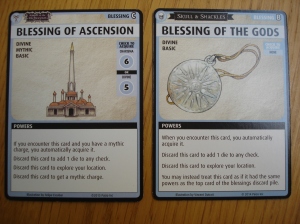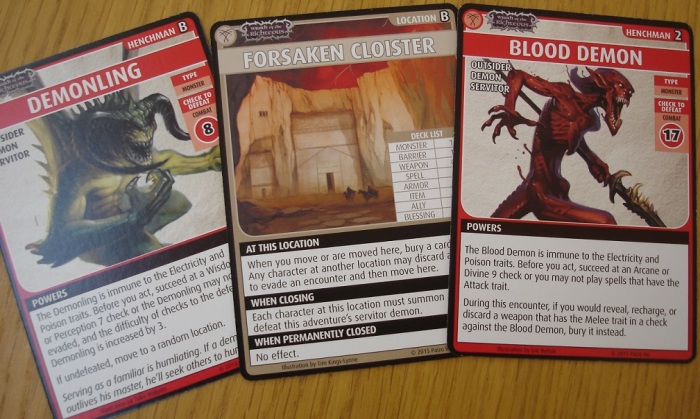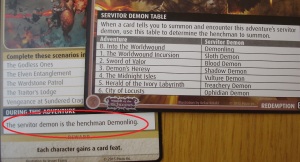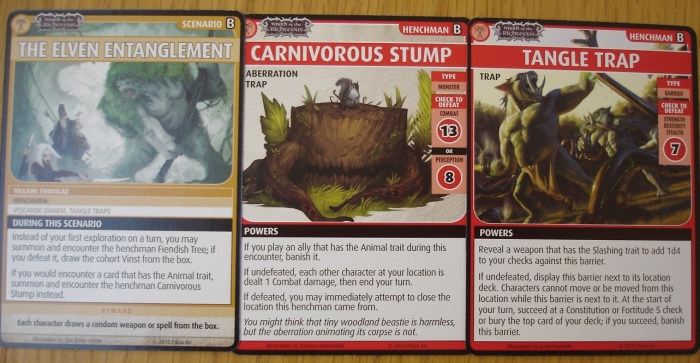Billionaire, Genius, Playboy, Philanthropist
Having looked a couple of weeks ago at Captain America, this week we consider his long-time team-mate, occasional rival, and all-round modest guy, Tony Stark, aka Iron Man.
Alongside Cap, Iron Man is the only character to have appeared in all 3 Marvel sets, as a starter character in Avengers vs X-Men, and a regular character in Uncanny X-Men, albeit it with a super-rare version. Once again, he boasts eleven cards*, with the dice from the first two sets distinguished only by the dice colour, and the latest, Age of UItron version, coming with a new energy type and stat-line.
*In fact, there is actually a 12th Iron Man card available, an organised play promo, which sees the Phoenix-buster incarnation of the Iron Man suit, making Iron Man the outright leader in terms of the number of cards available, but I feel like he needs taking down a peg or two, so I decided to make him wait.
Dice
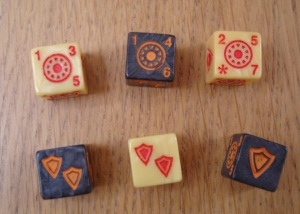 Of the two versions of Iron Man dice we have, the one from the first set is the more defensive, with 5, 6, 7 for defence and only 3, 4, 5 for attack.
Of the two versions of Iron Man dice we have, the one from the first set is the more defensive, with 5, 6, 7 for defence and only 3, 4, 5 for attack.
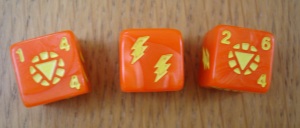 By contrast, the Age of Ultron dice only has a 3, 4, 4 defence, but 4, 4, 6 in attack. Both are a 1-1-2 field cost, which is lower than Captain America (1-2-2), meaning you’re less likely to need to hold back energy to field Iron Man, but possibly more likely to get caught out if you do roll the level 3.
By contrast, the Age of Ultron dice only has a 3, 4, 4 defence, but 4, 4, 6 in attack. Both are a 1-1-2 field cost, which is lower than Captain America (1-2-2), meaning you’re less likely to need to hold back energy to field Iron Man, but possibly more likely to get caught out if you do roll the level 3.
Cards
Avengers vs X-Men
The defensive dice in the first set are mirrored by the abilities:
Inventor – Cost 4 (Shield): Each time damage is dealt to Iron Man, reduce it by 1 (2 if he is at level 3 with his burst). This is a moderately useful ability – it makes Iron Man a bit harder to take out, but nothing to write home about. It certainly has more scope when combined with the global ability on this card “Pay [SHIELD] to redirect one damage from you to one of your characters” – if you have enough energy, all those single points of direct damage can be directed onto Iron Man and just disappear, but the problem with this strategy is that if you opponent is doing LOTS of direct damage, you’ll be spending so much energy on the global that you can’t do anything on the attack, and if they aren’t then the damage was probably little enough that you could have lived with it.
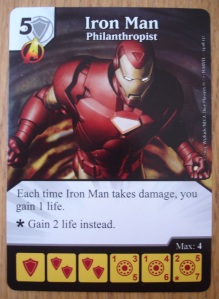 Philanthropist – Cost 5 (Shield): Each time Iron Man takes damage, you gain a life- 2 life if he’s on his burst level. It’s a shame that the burst is only on the top-level, so you’re going to have to work hard to get him there if he doesn’t start there, and pay the 2 field-cost if he does, but otherwise, this feels like a pretty good deal. He’s comfortably large enough to block things without getting taken out too often, and even a 1-point life-gain is good. Unless you have lots of dice active, you probably won’t want to attack with Iron Man, but if you do, your opponent has to decide between letting him through unblocked, or giving you another life as they block him. This certainly isn’t a card I’ve seen a lot of, but I definitely feel it’s got potential.
Philanthropist – Cost 5 (Shield): Each time Iron Man takes damage, you gain a life- 2 life if he’s on his burst level. It’s a shame that the burst is only on the top-level, so you’re going to have to work hard to get him there if he doesn’t start there, and pay the 2 field-cost if he does, but otherwise, this feels like a pretty good deal. He’s comfortably large enough to block things without getting taken out too often, and even a 1-point life-gain is good. Unless you have lots of dice active, you probably won’t want to attack with Iron Man, but if you do, your opponent has to decide between letting him through unblocked, or giving you another life as they block him. This certainly isn’t a card I’ve seen a lot of, but I definitely feel it’s got potential.
Playboy – Cost 4 (Shield): When this version of Iron Man takes damage in the attack step, he does 3 damage to an opposing character that it either attacking or blocking. There’s probably some utility here for removing opponent’s characters- or at least forcing them to be a bit more careful with which characters they use in attack/defence if they don’t want them knocked out, but overall this feels very underwhelming.
Billionaire – Cost 6 (Shield): Fittingly, given the title, this is the most expensive version of Iron Man in this first set, and he is immune to damage from all characters except those of the shield Energy Type. You don’t need a Tony Stark intellect to figure out that the utility of this will fluctuate wildly, depending on what characters your opponent is trying to damage Iron Man with – it might completely neutralise their strategy, it might do nothing. Given how many of the direct damage effects come from bolt characters, this one looks strong: it’s immune to Human Torch, Punisher, or Firestorm. It also nullifies damage from something like Hulk: Green Goliath, or Toad: Tongue Lashing when he forces you to attack. However, this ability only prevents damage, so it would be useless against something like Wind-Rider which re-rolls dice, or something like Hulk: Jade Giant which just KOs you.
Uncanny X-Men
Moving onto Uncanny X-Men, with the shift from Red on Yellow to Orange on Black, Iron Man got himself bumped up to Super-Rare, ensuring that people took a bit of notice of him.
This time, Mr Stark was showing a level of morality that his personality sometimes allows you to forget, with his common and Super-Rare versions interacting heavily with Villains, whilst the Rare version tapped in to the “Heroic” mechanic. As with Cap, I’m going to leave Heroic to another article another day, and just focus on the other versions.
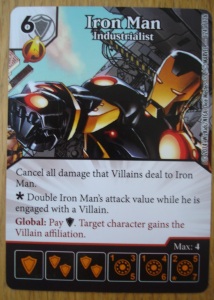 Upright – Cost 5 (Shield): This Iron Man takes 1 (*2) less damage from villains, which is a reasonable ability that only gets better with his global that allows you to pay a shield and make a character a villain for the turn. In fact, probably the biggest argument against this card is the Super-Rare…
Upright – Cost 5 (Shield): This Iron Man takes 1 (*2) less damage from villains, which is a reasonable ability that only gets better with his global that allows you to pay a shield and make a character a villain for the turn. In fact, probably the biggest argument against this card is the Super-Rare…
Industrialist – Cost 6 (Shield): For only 1 extra purchase cost, this Iron Man cancels ALL damage dealt to him by Villains. On level 3 his burst also double his attack when engaged with a villain, to a whopping 10, enough to knock out pretty much any character in the game – find a way of giving him Overcrush, and use the global to make something small a Villain, and you’ve got the potential for some serious damage. Obviously 6 cost is nothing to be ignored, nor is two field-cost, but for 6 vs 5, this definitely feels like the best option.
Promo
Phoenix Buster – Cost 7 (Shield): The Phoenix-Buster version of Iron Man came out in late 2014 as a promo-card for organised play. It uses the dice from the Avengers vs X-Men set, and is legal for most formats of the game.
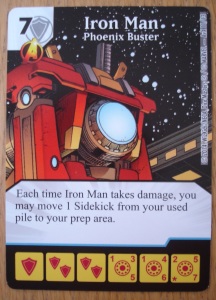
At 7 cost it is the most expensive version of Iron Man out there, and as such the card ability seems a little bit underwhelming, allowing you to move a sidekick from your used pile to your prep area, whenever he takes damage – to put it in perspective, this is half the effect of the global ability on the Uncanny X-Men version of Professor Xavier, and rather than costing a mask energy (something easily doable on turn 1 or 2) it requires you to damage a 7-cost character.
I like the organised play promos in this game, (just being a bit OCD about complete sets), and I think it’s good for the game that they aren’t super-powerful, but I can’t really see a good reason to play this.
Age of Ultron
As with Cap, set 3 sees a new energy type, but the same character name, so you can’t mix-and-match, the dice are slightly more offensive (and bolts rather than shields).
Big Man – Cost 3 (Bolt): The only blank Iron Man so far, this essentially becomes a consideration of stats and affiliations rather than abilities.
As I started to write this section, I decided that it really belonged in a wider discussion about the utility of blank cards, which will be appearing shortly. For now, suffice it to say that I think this card is interesting, but ultimately not worthwhile.
Genius – Cost 4 (Bolt) for one more than the blank version of Iron Man, you can consider any of the other versions in this set. Genius is a simple Teamwatch version which allows you to boost his attack by 1 each time you field another Avenger. This certainly isn’t a bad ability, but even with an all-avengers build, you’re never likely to be fielding more than a couple of Avengers on a turn, so I wonder how useful it really is.
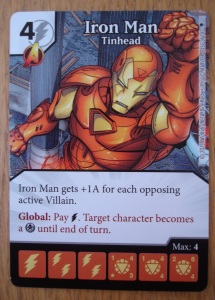 Invincible – Cost 4 (Bolt) Going it alone, this version of Iron Man boosts his own attack, by paying a bolt – this is much more predictable than the genius iteration, although it caps out at 2 (3 if you have Iron Man on his lowest level). Again, not a bad ability, and you could certainly profit from it, but I can’t see anyone building a team around it.
Invincible – Cost 4 (Bolt) Going it alone, this version of Iron Man boosts his own attack, by paying a bolt – this is much more predictable than the genius iteration, although it caps out at 2 (3 if you have Iron Man on his lowest level). Again, not a bad ability, and you could certainly profit from it, but I can’t see anyone building a team around it.
Tinhead – Cost 4 (Bolt) The final version of Iron Man in this set, this feels like the most useful of the aggressive Iron Men, getting +1A for each attacking opposing villain. Add in the fact that he comes with a global to turn any character into a villain by paying a bolt, and there is serious potential here, either to take out your opponent’s key defender, or to give him Overcrush and start knocking down your opponent’s life totals. Without the global, I think this would be too risky (no effect against a villain-less team) but as it is, this is the stand-out amongst the v2.0 Iron Man cards for me.
Allies
Aside from Iron Man himself, it’s also worth noting that there are other characters out there who interact directly with Iron Man – it is thematically fitting that these are War Machine and Pepper Potts.
War Machine is a decent combatant in his own right, able to attack and block with good numbers, and he only becomes more effective when Iron Man is active – my personal favourite is the uncommon version who becomes unblockable – whilst he’s not going to cause as much damage as a high-level Wolverine, (his attack is a 3, 4, 5 on the 3 levels) the set-up is probably less tricky to pull off, and having Iron Man active as either a blocker or an attacker in the meantime is hardly a downside.
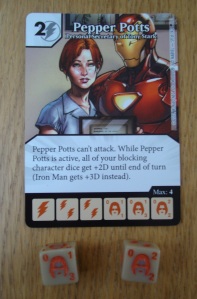 Pepper Potts is a slightly harder character to appraise – on one level, a 2-cost bolt character seems like a win, however feeble the stats. However, the fact that she can never attack reduces her utility as a cheap first-strike type. The fact that she is zero field-cost on all 3 levels and has various utility powers (+2D to blockers, spin opposing dice down a level [and damage them when Iron Man is active], or fetch and field an Iron Man for free on knock-out) makes it hard to argue that she’s bad value for energy, but whether she’s really as much use as you’d like is open to question. I’ve seen the global defence boost used to good effect, either for creating a wall, or helping to neutralise a build centred around Overcrush, and this is probably the one which has the least need to be tied to an Iron Man dice.
Pepper Potts is a slightly harder character to appraise – on one level, a 2-cost bolt character seems like a win, however feeble the stats. However, the fact that she can never attack reduces her utility as a cheap first-strike type. The fact that she is zero field-cost on all 3 levels and has various utility powers (+2D to blockers, spin opposing dice down a level [and damage them when Iron Man is active], or fetch and field an Iron Man for free on knock-out) makes it hard to argue that she’s bad value for energy, but whether she’s really as much use as you’d like is open to question. I’ve seen the global defence boost used to good effect, either for creating a wall, or helping to neutralise a build centred around Overcrush, and this is probably the one which has the least need to be tied to an Iron Man dice.
Having mentioned it for Captain America, it would also seem churlish not to point out that Iron Man is also an Avenger in all his iterations, meaning that he can be fielded for free if you have the common Nick Fury from AvX active.
Conclusion
I think each of the sets offers an Iron Man worth bringing to the table: for me, Philanthropist, Industrialist (if you can get it) and Tinhead are the ones to go for. The War Machine synergy is certainly nice, but I’m less convinced about Pepper, as the version which seems most useless (the defence boost) effects other characters equally whether Iron Man is around or not. I think Iron Man works best in either an Avengers-themed build, or in some kind of villain-based setting, where you can use the global abilities to set up additional tricks.

